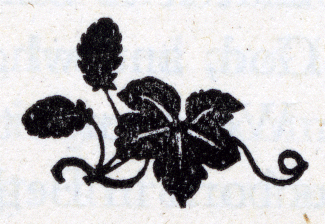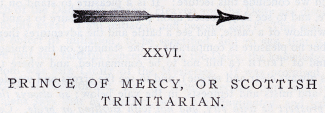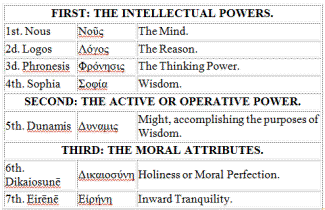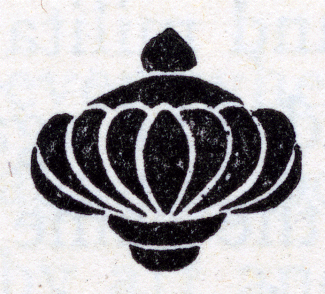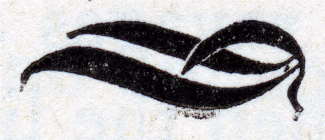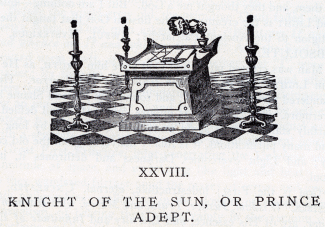XXV KNIGHT OF THE BRAZEN SERPENT.
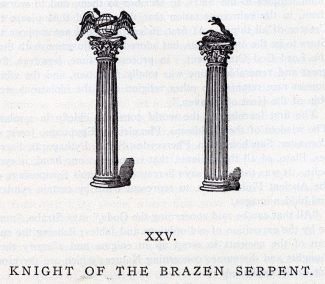
THIS Degree is both philosophical and moral. While it teaches the necessity of reformation as well as repentance, as a means of obtaining mercy and forgiveness, it is also devoted to an explanation of the symbols of Masonry; and especially to those which are connected with that ancient and universal legend, of which that of Khir-Om Abi is but a variation; that legend which, representing a murder or a death, and a restoration to life, by a drama in which figure Osiris, Isis and Horus, Atys and Cybele, Adonis and Venus, the Cabiri, Dionusos, and many another representative of the active and passive Powers of Nature, taught the Initiates in the Mysteries that the rule of Evil and Darkness is but temporary, and that that of Light and Good will be eternal.
Maimonides says: "In the days of Enos, the son of Seth, men fell into grievous errors, and even Enos himself partook of their infatuation. Their language was, that since God has placed on high the heavenly bodies, and used them as His ministers, it was evidently His will that they should receive from man the same veneration as the servants of a great prince justly claim from the subject multitude. Impressed with this notion, they began to build temples to the Stars, to sacrifice to them, and to worship them, in the vain expectation that they should thus please the Creator of all things. At first, indeed, they did not suppose the Stars to be the only Deities, but adored in conjunction with them the Lord God Omnipotent. In process of time, however, that great and venerable Name was totally forgotten, and the whole human race retained no other religion than the idolatrous worship of the Host of Heaven."
The first learning in the world consisted chiefly in symbols. The wisdom of the Chaldæans, Phœnicians, Egyptians, Jews; of Zoroaster, Sanchoniathon, Pherecydes, Syrus, Pythagoras, Socrates, Plato, of all the ancients, that is come to our hand, is symbolic. It was the mode, says Serranus on Plato's Symposium, of the Ancient Philosophers, to represent truth by certain symbols and hidden images.
"All that can be said concerning the Gods," says Strabo, "must be by the exposition of old opinions and fables; it being the custom of the ancients to wrap up in enigma and allegory their thoughts and discourses concerning Nature; which are therefore not easily explained."
As you learned in the 24th Degree, my Brother, the ancient Philosophers regarded the soul of man as having had its origin in Heaven. That was, Macrobius says, a settled opinion among them all; and they held it to be the only true wisdom, for the soul, while united with the body, to look ever toward its source, and strive to return to the place whence it came. Among the fixed stars it dwelt, until, seduced by the desire of animating a body, it descended to be imprisoned in matter. Thenceforward it has no other resource than recollection, and is ever attracted toward its birth-place and home. The means of return are to be sought for in itself. To re-ascend to its source, it must do and suffer in the body.
Thus the Mysteries taught the great doctrine of the divine nature and longings after immortality of the soul, of the nobility of its origin, the grandeur of its destiny, its superiority over the animals who have no aspirations heavenward. If they struggled in vain to express its nature, by comparing it to Fire and Light,--if they erred as to its original place of abode, and the mode of its descent, and the path which, descending and ascending, it pursued among the stars and spheres, these were the accessories of the Great Truth, and mere allegories designed to make the idea more impressive, and, as it were, tangible, to the human mind.
Let us, in order to understand this old Thought, first follow the soul in its descent. The sphere or Heaven of the fixed stars was that Holy Region, and those Elysian Fields, that were the native domicile of souls, and the place to which they re-ascended, when they had recovered their primitive purity and simplicity. From that luminous region the soul set forth, when it journeyed toward the body; a destination which it did not reach until it had undergone three degradations, designated by the name of Deaths; and until it had passed through the several spheres and the elements. All souls remained in possession of Heaven and of happiness, so long as they were wise enough to avoid the contagion of the body, and to keep themselves from any contact with matter. But those who, from that lofty abode, where they were lapped in eternal light, have looked longingly toward the body, and toward that which we here below call life, but which is to the soul a real death; and who have conceived for it a secret desire,--those souls, victims of their concupiscence, are attracted by degrees toward the inferior regions of the world, by the mere weight of thought and of that terrestrial desire. The soul, perfectly incorporeal, does not at once invest itself with the gross envelope of the body, but little by little, by successive and insensible alterations, and in proportion as it removes further and further from the simple and perfect substance in which it dwelt at first. It first surrounds itself with a body composed of the substance of the stars; and afterward, as it descends through the several spheres, with ethereal matter more and more gross, thus by degrees descending to an earthly body; and its number of degradations or deaths being the same as that of the spheres which it traverses.
The Galaxy, Macrobius says, crosses the Zodiac in two opposite points, Cancer and Capricorn, the tropical points in the sun's course, ordinarily called the Gates of the Sun. These two tropics, before his time, corresponded with those constellations, but in his day with Gemini and Sagittarius, in consequence of the precession of the equinoxes; but the signs of the Zodiac remained unchanged; and the Milky Way crossed at the signs Cancer and Capricorn, though not at those constellations.
Through these gates souls were supposed to descend to earth and re-ascend to Heaven. One, Macrobius says, in his dream of Scipio, was styled the Gate of Men; and the other, the Gate of the Gods. Cancer was the former, because souls descended by it to the earth; and Capricorn the latter, because by it they re-ascended to their seats of immortality, and became Gods. From the. Milky Way, according to Pythagoras, diverged the route to the dominions of Pluto. Until they left the Galaxy, they were not deemed to have commenced to descend toward the terrestrial bodies. From that they departed, and to that they returned. Until they reached the sign Cancer, they had not left it, and were still Gods. When they reached Leo, they commenced their apprenticeship for their future condition; and when they were at Aquarius, the sign opposite Leo, they were furthest removed from human life.
The soul, descending from the celestial limits, where the Zodiac and Galaxy unite, loses its spherical shape, the shape of all Divine Nature, and is lengthened into a cone, as a point is lengthened into a line; and then, an indivisible monad before, it divides itself and becomes a dead--that is, unity becomes division, disturbance, and conflict. Then it begins to experience the disorder which reigns in matter, to which it unites itself, becoming, as it were, intoxicated by draughts of grosser matter: of which inebriation the cup of Bakchos, between Cancer and Leo, is a symbol. It is for them the cup of forgetfulness. They assemble, says Plato, in the fields of oblivion, to drink there the water of the river Ameles, which causes men to forget everything. This fiction is also found in Virgil. "If souls," says Macrobius, "carried with them into the bodies they occupy all the knowledge which they had acquired of divine things, during their sojourn in the Heavens, men would not differ in opinion as to the Deity; but some of them forget more, and some less, of that which they had learned."
We smile at these notions of the ancients; but we must learn to look through these material images and allegories, to the ideas, struggling for utterance, the great speechless thoughts which they envelop: and it is well for us to consider whether we ourselves have yet found out any better way of representing to ourselves the soul's origin and its advent into this body, so entirely foreign to it; if, indeed, we have ever thought about it at all; or have not ceased to think, in despair.
The highest and purest portion of matter, which nourishes and constitutes divine existences, is what the poets term nectar, the beverage of the Gods. The lower, more disturbed and grosser portion, is what intoxicates souls. The ancients symbolized it as the River Lethe, dark stream of oblivion. How do we explain the soul's forgetfulness of its antecedents, or reconcile that utter absence of remembrance of its former condition, with its essential immortality? In truth, we for the most part dread and shrink from any attempt at explanation of it to ourselves.
Dragged down by the heaviness produced by this inebriating draught, the soul falls along the zodiac and the milky way to the lower spheres, and in its descent not only takes, in each sphere, a new envelope of the material composing the luminous bodies of the planets, but receives there the different faculties which it is to exercise while it inhabits the body.
In Saturn, it acquires the power of reasoning and intelligence, or what is termed the logical and contemplative faculty. From Jupiter it receives the power of action. Mars gives it valor, enterprise, and impetuosity. From the Sun it receives the senses and imagination, which produce sensation, perception, and thought. Venus inspires it with desires. Mercury gives it the faculty of expressing and enunciating what it thinks and feels. And, on entering the sphere of the Moon, it acquires the force of generation and growth. This lunary sphere, lowest and basest to divine bodies, is first and highest to terrestrial bodies. And the lunary body there assumed by the soul, while, as it were, the sediment of celestial matter, is also the first substance of animal matter.
The celestial bodies, Heaven, the Stars, and the other Divine elements, ever aspire to rise. The soul reaching the region which mortality inhabits, tends toward terrestrial bodies, and is deemed to die. Let no one, says Macrobius, be surprised that we so frequently speak of the death of this soul, which yet we call immortal. It is neither annulled nor destroyed by such death: but merely enfeebled for a time; and does not thereby forfeit its prerogative of immortality; for afterward, freed from the body, when it has been purified from the vice-stains contracted during that connection, it is re-established in all its privileges, and returns to the luminous abode of its immortality.
On its return, it restores to each sphere through which it ascends, the passions and earthly faculties received from them: to the Moon, the faculty of increase and diminution of the body; to Mercury, fraud, the architect of evils; to Venus, the seductive love of pleasure; to the Sun, the passion for greatness and empire; to Mars, audacity and temerity; to Jupiter, avarice; and to Saturn, falsehood and deceit: and at last, relieved of all, it enters naked and pure into the eighth sphere or highest Heaven.
All this agrees with the doctrine of Plato, that the soul cannot re-enter into Heaven, until the revolutions of the Universe shall have restored it to its primitive condition, and purified it from the effects of its contact with the four elements.
This opinion of the pre-existence of souls, as pure and celestial substances, before their union with our bodies, to put on and animate which they descend from Heaven, is one of great antiquity. A modern Rabbi, Manasseh Ben Israel, says it was always the belief of the Hebrews. It was that of most philosophers who admitted the immortality of the soul: and therefore it was taught in the Mysteries; for, as Lactantius says, they could not see how it was possible that the soul should exist after the body, if it had not existed before it, and if its nature was not independent of that of the body. The same doctrine was adopted by the most learned of the Greek Fathers, and by many of the Latins: and it would probably prevail largely at the present day, if men troubled themselves to think upon this subject at all, and to inquire whether the soul's immortality involved its prior existence.
Some philosophers held that the soul was incarcerated in the body, by way of punishment for sins committed by it in a prior state. How they reconciled this with the same soul's unconsciousness of any such prior state, or of sin committed there, does not appear. Others held that God, of his mere will, sent the soul to inhabit the body. The Kabalists united the two opinions. They held that there are four worlds, Aziluth, Briarth, Jezirath, and Aziath; the world of emanation, that of creation, that of forms, and the material world; one above and more perfect than the other, in that order, both as regards their own nature and that of the beings who inhabit them. All souls are originally in the world Aziluth, the Supreme Heaven, abode of God, and of pure and immortal spirits. Those who descend from it without fault of their own, by God's order, are gifted with a divine fire, which preserves them from the contagion of matter, and restores them to Heaven so soon as their mission is ended. Those who descend through, their own fault, go from world to world, insensibly losing their love of Divine things, and their self-contemplation; until they reach the world Aziath, falling by their own weight. This is a pure Platonism, clothed with the images and words peculiar to the Kabalists. It was the doctrine of the Essenes, who, says Porphyry, "believe that souls descend from the most subtile ether, attracted to bodies by the seductions of matter." It was in substance the doctrine of Origen; and it came from the Chaldæans, who largely studied the theory of the Heavens, the spheres, and the influences of the signs and constellations.
The Gnostics made souls ascend and descend through eight Heavens, in each of which were certain Powers that opposed their return, and often drove them back to earth, when not sufficiently purified. The last of these Powers, nearest the luminous abode of souls, was a serpent or dragon.
In the ancient doctrine, certain Genii were charged with the duty of conducting souls to the bodies destined to receive them, and of withdrawing them from those bodies. According to Plutarch, these were the functions of Proserpine and Mercury. In Plato, a familiar Genius accompanies man at his birth, follows and watches him all his life, and at death conducts him to the tribunal of the Great Judge. These Genii are the media of communication between man and the Gods; and the soul is ever in their presence. This doctrine is taught in the oracles of Zoroaster: and these Genii were the Intelligences that resided in the planets.
Thus the secret science and mysterious emblems of initiation were connected with the Heavens, the Spheres, and the Constellations: and this connection must be studied by whomsoever would understand the ancient mind, and be enabled to interpret the allegories, and explore the meaning of the symbols, in which the old sages endeavored to delineate the ideas that struggled within them for utterance, and could be but insufficiently and inadequately expressed by language, whose words are images of those things alone that can be grasped by and are within the empire of the senses.
It is not possible for us thoroughly to appreciate the feelings with which the ancients regarded the Heavenly bodies, and the ideas to which their observation of the Heavens gave rise, because we cannot put ourselves in their places, look at the stars with their eyes in the world's youth, and divest ourselves of the knowledge which even the commonest of us have, that makes us regard the Stars and Planets and all the Universe of Suns and Worlds, as a mere inanimate machine and aggregate of senseless orbs, no more astonishing, except in degree, than a clock or an orrery. We wonder and are amazed at the Power and Wisdom (to most men it seems only a kind of Infinite Ingenuity) of the MAKER: they wondered at the Work, and endowed it with Life and Force and mysterious Powers and mighty Influences.
Memphis, in Egypt, was in Latitude 29° 5" North, and in Longitude 30° 18' East. Thebes, in Upper Egypt, in Latitude 25° 45' North, and Longitude 32° 43' East. Babylon was in Latitude 32° 30' North, and Longitude 44° 23' East: while Saba, the ancient Sabæan capital of Ethiopia, was about in Latitude 15° North.
Through Egypt ran the great River Nile, coming from beyond Ethiopia, its source in regions wholly unknown, in the abodes of heat and fire, and its course from South to North. Its inundations had formed the alluvial lands of Upper and Lower Egypt, which they continued to raise higher and higher, and to fertilize by their deposits. At first, as in all newly-settled countries, those inundations, occurring annually and always at the same period of the year, were calamities: until, by means of levees and drains and artificial lakes for irrigation, they became blessings, and were looked for with joyful anticipation, as they had before been awaited with terror. Upon the deposit left by the Sacred River, as it withdrew into its banks, the husbandman sowed his seed; and the rich soil and the genial sun insured him an abundant harvest.
Babylon lay on the Euphrates, which ran from Southeast to Northwest, blessing, as all rivers in the Orient do, the arid country through which it flowed; but its rapid and uncertain overflows bringing terror and disaster.
To the ancients, as yet inventors of no astronomical instruments, and looking at the Heavens with the eyes of children, this earth was a level plain of unknown extent. About its boundaries there was speculation, but no knowledge. The inequalities of its surface were the irregularities of a plane. That it was a globe, or that anything lived on its under surface, or on what it rested, they had no idea. Every twenty-four hours the sun came up from beyond the Eastern rim of the world, and travelled across the sky, over the earth, always South of, but sometimes nearer and sometimes further from the point overhead; and sunk below the world's Western rim. With him went light, and after him followed darkness.
And every twenty-four hours appeared in the Heavens another body, visible chiefly at night, but sometimes even when the sun shone, which likewise, as if following the sun at a greater or less distance, travelled across the sky; sometimes as a thin crescent, and thence increasing to a full orb resplendent with silver light; and sometimes more and sometimes less to the Southward of the point overhead, within the same limits as the Sun.
Man, enveloped by the thick darkness of profoundest night, when everything around him has disappeared, and he seems alone with himself and the black shades that surround him, feels his existence a blank and nothingness, except so far as memory recalls to him the glories and splendors of light. Everything is dead to him, and he, as it were, to Nature. How crushing and overwhelming the thought, the fear, the dread, that perhaps that darkness may be eternal, and that day may possibly never return; if it ever occurs to his mind, while the solid gloom closes up against him like a wall! What then can restore him to like, to energy, to activity, to fellowship and communion with the great world which God has spread around him, and which perhaps in the darkness may be passing away? LIGHT restores him to himself and to nature which seemed lost to him. Naturally, therefore, the primitive men regarded light as the principle of their real existence, without which life would be but one continued weariness and despair. This necessity for light, and its actual creative energy, were felt by all men: and nothing was more alarming to them than its absence. It became their first Divinity, a single ray of which, flashing into the dark tumultuous bosom of chaos, caused man and all the Universe to emerge from it. So all the poets sung who imagined Cosmogonies; such was the first dogma of Orpheus, Moses, and the Theologians. Light was Ormuzd, adored by the Persians, and Darkness Ahriman, origin of all evils: Light was the life of the Universe, the friend of man, the substance of the Gods and of the Soul.
The sky was to them a great, solid, concave arch; a hemisphere of unknown material, at an unknown distance above the flat level earth; and along it journeyed in their courses the Sun, the Moon, the Planets, and the Stars.
The Sun was to them a great globe of fire, of unknown dimensions, at an unknown distance. The Moon was a mass of softer light; the stars and planets lucent bodies, armed with unknown and supernatural influences.
It could not fail to be soon observed, that at regular intervals the days and nights were equal; and that two of these intervals measured the same space of time as elapsed between the successive inundations, and between the returns of spring-time and harvest. Nor could it fail to be perceived that the changes of the moon occurred regularly; the same number of days always elapsing between the first appearance of her silver crescent in the West at evening and that of her full orb rising in the East at the same hour; and the same again, between that and the new appearance of the crescent in the West.
It was also soon observed that the Sun crossed the Heavens in a different line each day, the days being longest and the nights shortest when the line of his passage was furthest North, and the days shortest and nights longest when that line was furthest South: that his progress North and South was perfectly regular, marking four periods that were always the same,--those when the days and nights were equal, or the Vernal and Autumnal Equinoxes; that when the days were longest, or the Summer Solstice; and that when they were shortest, or the Winter Solstice.
With the Vernal Equinox, or about the 25th of March of our Calendar, they found that there unerringly came soft winds, the return of warmth, caused by the Sun turning back to the Northward from the middle ground of his course, the vegetation of the new year, and the impulse to amatory action on the part of the animal creation. Then the Bull and the Ram, animals most valuable to the agriculturist, and symbols themselves of vigorous generative power, recovered their vigor, the birds mated and budded their nests, the seeds germinated, the grass grew, and the trees put forth leaves. With the Summer Solstice, when the Sun reached the extreme northern limit of his course, came great heat, and burning winds, and lassitude and exhaustion; then vegetation withered, man longed for the cool breezes of Spring and Autumn, and the cool water of the wintry Nile or Euphrates, and the Lion sought for that element far from his home in the desert.
With the Autumnal Equinox came ripe harvests, and fruits of the tree and vine, and falling leaves, and cold evenings presaging wintry frosts; and the Principle and Powers of Darkness, prevailing over those of Light, drove the Sun further to the South, so that the nights grew longer than the days. And at the Winter Solstice the earth, was wrinkled with frost, the trees were leafless, and the Sun reaching the most Southern point in his career, seemed to hesitate whether to continue descending, to leave the world to darkness and despair, or to turn upon his steps and retrace his course to the Northward, bringing back seed-time and Spring, and green leaves and flowers, and all the delights of love.
Thus, naturally and necessarily, time was divided, first into days, and then into moons or months, and years; and with these divisions and the movements of the Heavenly bodies that marked them, were associated and connected all men's physical enjoyments and privations. Wholly agricultural, and in their frail habitations greatly at the mercy of the elements and the changing seasons, the primitive people of the Orient were most deeply interested in the recurrence of the periodical phenomena presented by the two great luminaries of Heaven, on whose regularity all their prosperity depended.
And the attentive observer soon noticed that the smaller lights of Heaven were, apparently, even more regular than the Sun and Moon, and foretold with unerring certainty, by their risings and settings, the periods of recurrence of the different phenomena and seasons on which the physical well-being of all men depended. They soon felt the necessity of distinguishing the individual stars, or groups of stars, and giving them names, that they might understand each other, when referring to and designating them. Necessity produced designations at once natural and artificial. Observing that, in the circle of the year, the renewal and periodical appearance of the productions of the earth were constantly associated, not only with the courses of the Sun, but also with the rising and setting of certain Stars, and with their position relatively to the Sun, the centre to which they referred the whole starry host, the mind naturally connected the celestial and terrestrial objects that were in fact connected: and they commenced by giving to particular Stars or groups of Stars the names of those terrestrial objects which seemed connected with them; and for those which still remained unnamed by this nomenclature, they, to complete a system, assumed arbitrary and fanciful names.
Thus the Ethiopian of Thebes or Saba styled those Stars under which the Nile commenced to overflow, Stars of Inundation, or that poured out water (AQUARIUS).
Those Stars among which the Sun was, when he had reached the Northern Tropic and began to retreat Southward, were termed, from his retrograde motion, the Crab (CANCER).
As he approached, in Autumn, the middle point between the Northern and Southern extremes of his journeying, the days and nights became equal; and the Stars among which he was then found were called Stars of the Balance (LIBRA).
Those stars among which the Sun was, when the Lion, driven from the Desert by thirst, came to slake it at the Nile, were called Stars of the Lion (LEO).
Those among which the Sun was at harvest, were called those of the Gleaning Virgin, holding a Sheaf of Wheat (VIRGO).
Those among which he was found in February, when the Ewes brought forth their young, were called Stars of the Lamb (Arms).
Those in March, when it was time to plough, were called Stars of the Ox (TAURUS).
Those under which hot and burning winds came from the desert, venomous like poisonous reptiles, were called Stars of the Scorpion (SCORPIO).
Observing that the annual return of the rising of the Nile was always accompanied by the appearance of a beautiful Star, which at that period showed itself in the direction of the sources of that river, and seemed to warn the husbandman to be careful not to be surprised by the inundation, the Ethiopian compared this act of that Star to that of the Animal which by barking gives warning of danger, and styled it the Dog (SIRIUS).
Thus commencing, and as astronomy came to be more studied, imaginary figures were traced all over the Heavens, to which the different Stars were assigned. Chief among them were those that lay along the path which the Sun travelled as he climbed toward the North and descended to the South: lying within certain limits and extending to an equal distance on each side of the line of equal nights and days. This belt, curving like a Serpent, was termed the Zodiac, and divided into twelve Signs.
At the Vernal Equinox, 2455 years before our Era, the Sun was entering the sign and constellation Taurus, or the Bull; having passed through, since he commenced, at the Winter Solstice, to ascend Northward, the Signs Aquarius, Pisces and Aries; on entering the first of which he reached the lowest limit of his journey Southward.
From TAURUS, he passed through Gemini and Cancer, and reached LEO when he arrived at the terminus of his journey Northward. Thence, through Leo, Virgo, and Libra, he entered SCORPIO at the Autumnal Equinox, and journeyed Southward through Scorpia, Sagittarius, and Capricornus to AQUARIUS, the terminus of his journey South.
The path by which he journeyed through these signs became the Ecliptic; and that which passes through the two equinoxes, the Equator.
They knew nothing of the immutable laws of nature; and whenever the Sun commenced to tend Southward, they feared lest he might continue to do so, and by degrees disappear forever, leaving the earth to be ruled forever by darkness, storm, and cold.
Hence they rejoiced when he commenced to re-ascend after the Winter Solstice, struggling against the malign influences of Aquarius and Pisces, and amicably received by the Lamb. And when at the Vernal Equinox he entered Taurus, they still more rejoiced at the assurance that the days would again be longer than the nights, that the season of seed-time had come, and the Summer and harvest would follow.
And they lamented when, after the Autumnal Equinox, the malign influence of the venomous Scorpion, and vindictive Archer, and the filthy and ill-omened He-Goat dragged him down toward the Winter Solstice.
Arriving there, they said he had been slain, and had gone to the realm of darkness. Remaining there three days, he rose again, and again ascended Northward in the heavens, to redeem the earth from the gloom and darkness of Winter, which soon became emblematical of sin, and evil, and suffering; as the Spring, Summer, and Autumn became emblems of happiness and immortality.
Soon they personified the Sun, and worshipped him under the name of OSIRIS, and transmuted the legend of his descent among the Winter Signs, into 'a fable of his death, his descent into the infernal regions, and his resurrection.
The Moon became Isis, the wife of Osiris; and Winter, as well as the desert or the ocean into which the Sun descended, became TYPHON, the Spirit or Principle of Evil, warring against and destroying Osiris.
From the journey of the Sun through the twelve signs came the legend of the twelve labors of Hercules, and the incarnations of Vishnu and Buddha. Hence came the legend of the murder of Khūrūm, representative of the Sun, by the three Fellow-crafts, symbols of the three Winter signs, Capricornus, Aquarius, and Pisces, who assailed him at the three gates of Heaven and slew him at the Winter Solstice. Hence the search for him by the nine Fellow-crafts, the other nine signs, his finding, burial, and resurrection.
The celestial Taurus, opening the new year, was the Creative Bull of the Hindus and Japanese, breaking with his horn the egg out of which the world is born. Hence the bull Arts was worshipped by the Egyptians, and reproduced as a golden calf by Aaron in the desert. Hence the cow was sacred to the Hindus. Hence, from the sacred and beneficent signs of Taurus and Leo, the human-headed winged lions and bulls in the palaces at Kouyounjik and Nimroud, like which were the Cherubim set by Solomon in his Temple: and hence the twelve brazen or bronze oxen, on which the laver of brass was supported.
The Celestial Vulture or Eagle, rising and setting with the Scorpion, was substituted in its place, in many cases, on account of the malign influences of the latter: and thus the four great periods of the year were marked by the Bull, the Lion, the Man (Aquarius) and the Eagle; which were upon the respective standards of Ephraim, Judah, Reuben, and Dan; and still appear on the shield of American Royal Arch Masonry.
Afterward the Ram or Lamb became an object of adoration, when, in his turn, he opened the equinox, to deliver the world from the wintry reign of darkness and evil.
Around the central and simple idea of the annual death and resurrection of the Sun a multitude of circumstantial details soon clustered. Some were derived from other astronomical phenomena; while many were merely poetical ornaments and inventions.
Besides the Sun and Moon, those ancients also saw a beautiful Star, shining with a soft, silvery light, always following the Sun at no great distance when he set, or preceding him when he rose. Another of a red and angry color, and still another more kingly and brilliant than all, early attracted their attention, by their free movements among the fixed hosts of Heaven: and the latter by his unusual brilliancy, and the regularity with which he rose and set. These were Venus, Mars, and Jupiter. Mercury and Saturn could scarcely have been noticed in the world's infancy, or until astronomy began to assume the proportions of a science.
In the projection of the celestial sphere by the astronomical priests, the zodiac and constellations, arranged in a circle, presented their halves in diametrical opposition; and the hemisphere of Winter was said to be adverse, opposed, contrary, to that of Summer. Over the angels of the latter ruled a king (OSIRIS or ORMUZD), enlightened, intelligent, creative, and beneficent. Over the fallen angels or evil genii of the former, the demons or Devs of the subterranean empire of darkness and sorrow, and its stars, ruled also a chief. In Egypt the Scorpion first ruled, the sign next the Balance, and long the chief of the Winter signs; and then the Polar Bear or Ass, called Typhon, that is, deluge, on account of the rains which inundated the earth while that constellation domineered. In Persia, at a later day, it was the serpent, which, personified as Ahriman, was the Evil Principle of the religion of Zoroaster.
The Sun does not arrive at the same moment in each year at the equinoctial point on the equator. The explanation of his anticipating that point belongs to the science of astronomy; and to that we refer you for it. The consequence is, what is termed the precession of the equinoxes, by means of which the Sun is constantly changing his place in the zodiac, at each vernal equinox; so that now, the signs retaining the names which they had 300 years before Christ, they and the constellations do not correspond; the Sun being now in the constellation Pisces, when he is in the sign Aries.
The annual amount of precession is 50 seconds and a little over [50" 1.]. The period of a complete Revolution of the Equinoxes, 25,856 years. The precession amounts to 30° or a sign, in 2155.6 years. So that, as the sun now enters Pisces at the Vernal Equinox, he entered Aries at that period, 300 years B. C., and Taurus 2455 B. C. And the division of the Ecliptic, now called Taurus, lies in the Constellation Aries; while the sign Gemini is in the Constellation Taurus. Four thousand six hundred and ten years before Christ, the sun entered Gemini at the Vernal Equinox.
At the two periods, 2455 and 300 years before Christ, and now, the entrances of the sun at the Equinoxes and Solstices into the signs, were and are as follows:--
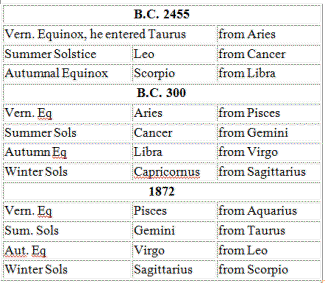
From confounding signs with causes came the worship of the sun and stars. "If," says Job, "I beheld the sun when it shined, or the moon progressive in brightness; and my heart hath been secretly enticed, or my mouth hath kissed my hand, this were an iniquity to be punished by the Judge; for I should have denied the God that is above."
Perhaps we are not, on the whole, much wiser than those simple men of the old time. For what do we know of effect and cause, except that one thing regularly or habitually follows another?
So, because the heliacal rising of Sirius preceded the rising of the Nile, it was deemed to cause it; and other stars were in like manner held to cause extreme heat, bitter cold, and watery storm.
A religious reverence for the zodiacal Bull [TAURUS] appears, from a very early period, to have been pretty general, perhaps it was universal, throughout Asia; from that chain or region of Caucasus to which it gave name; and which is still known under the appellation of Mount Taurus, to the Southern extremities of the Indian Peninsula; extending itself also into Europe, and through the Eastern parts of Africa.
This evidently originated during those remote ages of the world, when the colure of the vernal equinox passed across the stars in the head of the sign Taurus [among which was Aldebarán]; a period when, as the most ancient monuments of all the oriental nations attest, the light of arts and letters first shone forth.
The Arabian word AL-DE-BARÁN, means the foremost, or leading, star: and it could only have been so named, when it did precede, or lead, all others. The year then opened with the sun in Taurus; and the multitude of ancient sculptures, both in Assyria and Egypt, wherein the bull appears with lunette or crescent horns, and the disk of the sun between them, are direct allusions to the important festival of the first new moon of the year: and there was everywhere an annual celebration of the festival of the first new moon, when the year opened with Sol and Luna in Taurus.
David sings: "Blow the trumpet in the New Moon; in the time appointed; on our solemn feast-day: for this is a statute unto Israel, and a law of the God of Jacob. This he ordained to Joseph, for a testimony, when he came out of the land of Egypt."
The reverence paid to Taurus continued long after, by the precession of the Equinoxes, the colure of the vernal equinox had come to pass through Aries. The Chinese still have a temple, called "The Palace of the horned Bull"; and the same symbol is worshipped in Japan and all over Hindostan. The Cimbrians carried a brazen bull with them, as the image of their God, when they overran Spain and Gaul; and the representation of the Creation, by the Deity in the shape of a bull, breaking the shell of an egg with his horns, meant Taurus, opening the year, and bursting the symbolical shell of the annually-recurring orb of the new year.
Theophilus says that the Osiris of Egypt was supposed to be dead or absent fifty days in each year. Landseer thinks that this was because the Sabæan priests were accustomed to see, in the lower latitudes of Egypt and Ethiopia, the first or chief stars of the Husbandman [BOÖTES] sink achronically beneath the Western horizon; and then to begin their lamentations, or hold forth the signal for others to weep: and when his prolific virtues were supposed to be transferred to the vernal sun, bacchanalian revelry became devotion.
Before the colure of the Vernal Equinox had passed into Aries, and after it had left Aldebarán and the Hyades, the Pleiades were, for seven or eight centuries, the leading stars of the Sabæan year. And thus we see, on the monuments, the disk and crescent, symbols of the sun and moon in conjunction, appear successively,--first on the head, and then on the neck and back of the Zodiacal Bull, and more recently on the forehead of the Ram.
The diagrammatical character or symbol, still in use to denote Taurus,
 is this very crescent and disk: a symbol that has come down to us from those remote ages when this memorable conjunction in Taurus, by marking the commencement, at once of the Sabæan year and of the cycle of the Chaldæan Saros, so pre-eminently distinguished that sign as to become its characteristic symbol. On a bronze bull from China, the crescent is attached to the back of the Bull, by means of a cloud, and a curved groove is provided for the occasional introduction of the disk of the sun, when solar and lunar time were coincident and conjunctive, at the commencement of the year, and of the lunar cycle. When that was made, the year did not open with the stars in the head of the Bull, but when the colure of the vernal equinox passed across the middle or later degrees of the asterism Taurus, and the Pleiades were, in China, as in Canaan, the leading stars of the year.
is this very crescent and disk: a symbol that has come down to us from those remote ages when this memorable conjunction in Taurus, by marking the commencement, at once of the Sabæan year and of the cycle of the Chaldæan Saros, so pre-eminently distinguished that sign as to become its characteristic symbol. On a bronze bull from China, the crescent is attached to the back of the Bull, by means of a cloud, and a curved groove is provided for the occasional introduction of the disk of the sun, when solar and lunar time were coincident and conjunctive, at the commencement of the year, and of the lunar cycle. When that was made, the year did not open with the stars in the head of the Bull, but when the colure of the vernal equinox passed across the middle or later degrees of the asterism Taurus, and the Pleiades were, in China, as in Canaan, the leading stars of the year.The crescent and disk combined always represent the conjunctive Sun and Moon; and when placed on the head of the Zodiacal Bull, the commencement of the cycle termed SAROS by the Chaldæans, and Metonic by the Greeks; and supposed to be alluded to in Job, by the phrase, "Mazzaroth in his season"; that is to say, when the first new Moon and new Sun of the year were coincident, which happened once in eighteen years and a fraction.
On the sarcophagus of Alexander, the same symbol appears on the head of a Rain, which, in the time of that monarch, was the leading sign. So too in the sculptured temples of the Upper Nile, the crescent and disk appear, not on the head of Taurus, but on the forehead of the Ram or the Ram-headed God, whom the Grecian Mythologists called Jupiter Ammon, really the Sun in Aries.
If we now look for a moment at the individual stars which composed and were near to the respective constellations, we may find something that will connect itself with the symbols of the Ancient Mysteries and of Masonry.
It is to be noticed that when the Sun is in a particular constellation, no part of that constellation will be seen, except just before sunrise and just after sunset; and then only the edge of it: but the constellations opposite to it will be visible. When the Sun is in Taurus, for example, that is, when Taurus sets with the Sun, Scorpio rises as he sets, and continues visible throughout the night. And if Taurus rises and sets with the Sun to-day, he will, six months hence, rise at sunset and set at sunrise; for the stars thus gain on the Sun two hours a month.

